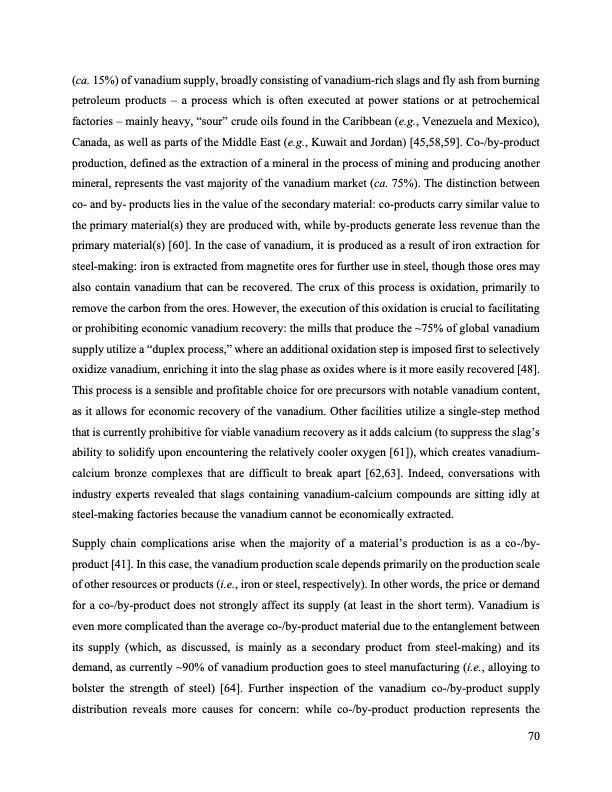
PDF Publication Title:
Text from PDF Page: 070
(ca. 15%) of vanadium supply, broadly consisting of vanadium-rich slags and fly ash from burning petroleum products – a process which is often executed at power stations or at petrochemical factories – mainly heavy, “sour” crude oils found in the Caribbean (e.g., Venezuela and Mexico), Canada, as well as parts of the Middle East (e.g., Kuwait and Jordan) [45,58,59]. Co-/by-product production, defined as the extraction of a mineral in the process of mining and producing another mineral, represents the vast majority of the vanadium market (ca. 75%). The distinction between co- and by- products lies in the value of the secondary material: co-products carry similar value to the primary material(s) they are produced with, while by-products generate less revenue than the primary material(s) [60]. In the case of vanadium, it is produced as a result of iron extraction for steel-making: iron is extracted from magnetite ores for further use in steel, though those ores may also contain vanadium that can be recovered. The crux of this process is oxidation, primarily to remove the carbon from the ores. However, the execution of this oxidation is crucial to facilitating or prohibiting economic vanadium recovery: the mills that produce the ~75% of global vanadium supply utilize a “duplex process,” where an additional oxidation step is imposed first to selectively oxidize vanadium, enriching it into the slag phase as oxides where is it more easily recovered [48]. This process is a sensible and profitable choice for ore precursors with notable vanadium content, as it allows for economic recovery of the vanadium. Other facilities utilize a single-step method that is currently prohibitive for viable vanadium recovery as it adds calcium (to suppress the slag’s ability to solidify upon encountering the relatively cooler oxygen [61]), which creates vanadium- calcium bronze complexes that are difficult to break apart [62,63]. Indeed, conversations with industry experts revealed that slags containing vanadium-calcium compounds are sitting idly at steel-making factories because the vanadium cannot be economically extracted. Supply chain complications arise when the majority of a material’s production is as a co-/by- product [41]. In this case, the vanadium production scale depends primarily on the production scale of other resources or products (i.e., iron or steel, respectively). In other words, the price or demand for a co-/by-product does not strongly affect its supply (at least in the short term). Vanadium is even more complicated than the average co-/by-product material due to the entanglement between its supply (which, as discussed, is mainly as a secondary product from steel-making) and its demand, as currently ~90% of vanadium production goes to steel manufacturing (i.e., alloying to bolster the strength of steel) [64]. Further inspection of the vanadium co-/by-product supply distribution reveals more causes for concern: while co-/by-product production represents the 70PDF Image | Bringing Redox Flow Batteries to the Grid

PDF Search Title:
Bringing Redox Flow Batteries to the GridOriginal File Name Searched:
Rodby-krodby-phd-chemE-2022-thesis.pdfDIY PDF Search: Google It | Yahoo | Bing
Salgenx Redox Flow Battery Technology: Salt water flow battery technology with low cost and great energy density that can be used for power storage and thermal storage. Let us de-risk your production using our license. Our aqueous flow battery is less cost than Tesla Megapack and available faster. Redox flow battery. No membrane needed like with Vanadium, or Bromine. Salgenx flow battery
| CONTACT TEL: 608-238-6001 Email: greg@salgenx.com | RSS | AMP |